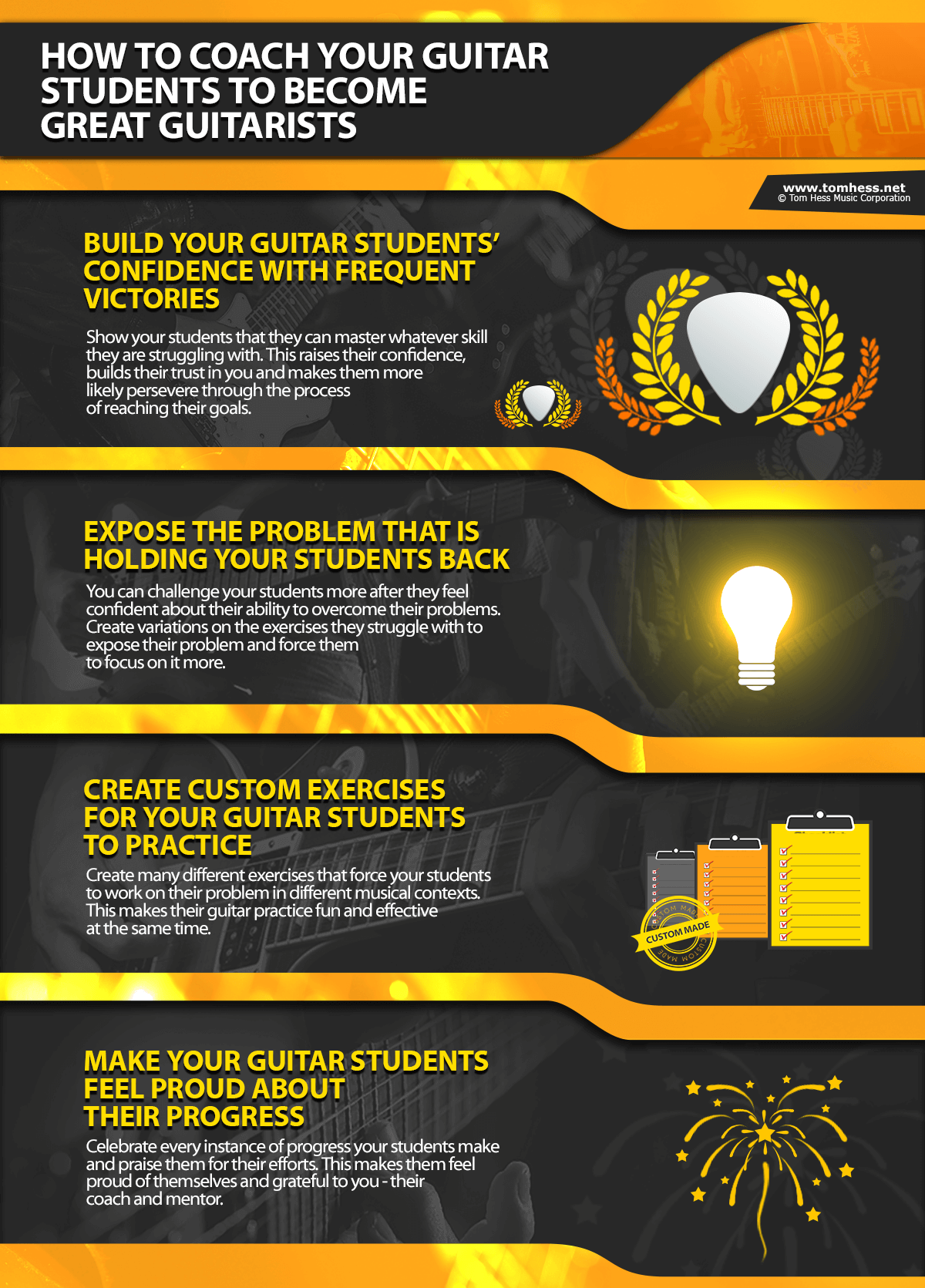The Best Guitar Teaching Format: Teaching Guitar In Groups Vs. 1-1 Guitar Lessons

EMAIL TO GET ACCESS
By submitting your info, you agree to send it to Tom Hess Music Corporation who will process and use it according to their privacy policy.
What is the best guitar teaching format?
Is it teaching guitar in groups? Or 1-1 guitar lessons?
Conventional guitar teaching wisdom says: 1-1 guitar lessons.
And if you ask why, everyone says: “because this guitar teaching format gives your guitar students your full attention”.
But if you ask: “Why else?”, you get…
Crickets!
That’s right.
I’ve yet to meet anyone teaching guitar who could name even TWO (so-called) advantages of 1-1 guitar lessons over teaching guitar in groups. (That isn’t just “your students get your full attention” in different words.)
Meanwhile…
I'm happy to give you not 1, not 2, not 3… but TEN solid reasons why teaching guitar in groups is not only better for you (the person teaching guitar) …
… but it also makes your guitar students better guitar players faster and helps them enjoy lessons with you way more.

EMAIL TO GET ACCESS
By submitting your info, you agree to send it to Tom Hess Music Corporation who will process and use it according to their privacy policy.
(Spoiler: one of these reasons will make you doubt if the “full attention” pro-1-1-lessons argument is even good.)
Let’s start the list:

Problem #1 With 1-1 Guitar Lessons: Your Guitar Students Don’t Develop Real-Life Playing Skills.
These real-life skills include: playing in time, stage presence, confidence and ability to jam with other musicians.
The reason why 1-1 guitar lessons don’t develop these skills is simple: your students only ever play in front of one person – you! All the other times they are practicing guitar on their own at home.
But playing music is not about playing guitar for only 1 person. It’s a dynamic activity - based on interaction with other musicians. Thus, no guitar player can avoid playing in front of other people.
And if you don’t help your students get better at playing with other musicians (as you are teaching guitar to them) – who will?
In a group guitar teaching format, there is no limit to how you can train your guitar students to jam and practice playing with each other.
This makes your students feel like real musicians instead of just ‘guitar players’.
Problem #2 With 1-1 Guitar Lessons: Your Guitar Students Feel Less Motivation To Improve.
When your guitar students learn 1-1, they don't see how well your other students are improving. Thus, they feel less positive pressure to improve their playing… and their progress becomes slower.
On the other hand, when teaching guitar in groups – your students often get inspired by your best performing students. This makes them more motivated to try harder, to practice more and thus – improve faster.

Problem #3 With 1-1 Guitar Lessons: Your Guitar Students Don't Develop The Self-Reliance They Need To Become Good Players
Every teacher who believes in 1-1 guitar lessons says they are better than group lessons because students get your full attention in the lesson.
And they ARE right as far as that goes. But there is a BIG problem with this:
After you teach your guitar students something, they need the mental space to practice it, make some mistakes and try to fix them ‘on their own’ before you get them back on track.
This process develops the self-reliance your students need to improve while they practice at home.
But students rarely develop this ability in 1-1 guitar lessons. Why? It’s because your attention is fully focused on them. Thus, they never go through the process of learning to practice on their own.
When teaching guitar in groups – your students get the space they need to practice on their own (while you train other students) before you check on them again.
Then, they have a chance to practice for a few minutes on their own once again before you correct them again.
This fragmented attention (that comes standard in the group guitar teaching format) develops better habits in your students and makes them improve faster.
And this leads us to:
Problem #4 With 1-1 Guitar Lessons: The “Additional Personal Attention” Students Get In 1-1 Lessons Stifles Their Progress.
In 1-1 lessons, students don't feel the need to pay as much attention, take notes or remember what you are showing them, because they know they have your full attention. In groups - students pay more attention, take notes and (usually) practice harder at home, so they can keep up with the rest of the group.
When I tell this to guitar teachers, some feel skeptical. So I ask them: “In all the years you’ve been teaching 1-1 guitar lessons, how many of your guitar students show up to every lesson with a pen, a notepad and actually take notes on every key point you say?”
Unless you tell them to do this, the answer is probably less than 5 people. The point is in 1-1 guitar lessons, students tend to not learn as well because they don’t pay as close attention. They know they can ask you next week to simply teach them the same things again. The amount of time (and money) the student wastes, as a result, is staggering.
In a group guitar teaching format, your students don't have the same capacity to waste that much time. They are forced to pay more attention as a result of being in a class. That helps them take more responsibility for their learning and thus progress much faster.
Problem #5 With 1-1 Guitar Lessons: You Make Way Less Money Teaching Guitar Than You Could Be Making.
This point may seem quite obvious, but…
… the amount of guitar teaching income you lose by only teaching 1-1 lessons (vs. doing group guitar teaching) is STUNNING.
I mean:
Even if you are a workhorse and can teach 70 one-hour 1-1 guitar lessons (with the buffers between students, make-ups and lesson prep time, you’re looking at 90+ hour work weeks)…
… you’ll still be left in the dust by any guitar teacher teaching guitar in groups (who can teach 250 students in 15-25 hours per week without breaking a sweat).
Multiply the above by your monthly lesson rate and get ready to cry.
But the guitar teaching income difference goes far beyond the mere “number of students you can teach”.
Because on top of making more money from your current students…
… group guitar teaching format leaves you with more energy and desire to attract more guitar students and scale your business further by hiring other guitar teachers to teach for you.
Problem #6 With 1-1 Guitar Lessons: You Get To Help Fewer People.
Even If you don't care all that much about having a high guitar teaching income and simply want to help more people…
Teaching guitar in groups is the better way to go.
When teaching guitar in groups, there is almost always room in your schedule to attract another guitar student whom you want to help.
But when teaching 1-1 guitar lessons?
After you are teaching guitar at full capacity, you end up having to put prospective guitar students on a waiting list. This only leaves you frustrated, because you know it’s one more guitar student whom you can’t help.
Pro tip: you never want your guitar teaching model to be the bottleneck in how many students you can teach.
Problem #7 With 1-1 Guitar Lessons: Your Guitar Students Progress Slower, Because They Don’t Learn From Your Other Students’ Questions.
When teaching 1-1 guitar lessons, your guitar students can only ask you their questions. And you can only comment about any mistakes you see in their playing.
But there are many things your students won’t think to ask (and thus may never learn about) unless they see/hear you talk about them to your other students.
Thus, when your students ask questions in a group – your other students benefit from both their questions and your answer.
This kind of interaction cannot happen in 1-1 guitar lessons.
Question: “But Tom Hess, this is the reason people don’t like group lessons group guitar teaching format! They don’t want to feel stupid asking questions in front of others.”
Answer: This “problem” can be solved by showing your students how asking questions helps everyone and makes them feel safe. When you do it right, even the shyest students become comfortable asking questions in a group guitar teaching format. I can help you with teaching guitar in groups in my guitar teacher training program.

Problem #8 With 1-1 Guitar Lessons: It Becomes Hard To Reschedule Missed Lessons.
When teaching guitar in groups, this problem becomes easy to solve.
Now you can let the student make up the missed lesson simply by attending another class you’ll be teaching anyway. This way, everyone is happy, and you don’t have to teach make-up lessons ever again.
Problem #9 With 1-1 Guitar Lessons: You Work A Lot More Hours.
This happens for 2 reasons:
A. you spend more time teaching the students you have (compared to teaching guitar in groups), and…
B. you spend a lot of time replacing the students who quit, because of…
Problem #10 With 1-1 Guitar Lessons: Your Guitar Students Don't Stay With You As Long.
Why does this happen? Simple:
The monotony of 1-1 guitar lessons can become boring for students (especially when a student is much younger or much older than you). This often makes them decide to quit (since guitar students only continue coming to lessons if they are fun).
On the flip side:
When you are teaching guitar in groups…
You can easily put together a group of students of similar ages. This makes them bond with each other and helps you keep them in lessons much longer.
On top of that, group guitar teaching is much more dynamic. Your students (and you) will crack jokes, tell stories, and have more fun during lessons than they ever would when they are in a room with just their teacher.
Pro tip: the more fun you make your guitar teaching – the longer your guitar students stay with you.
Question: “Tom Hess, what’s the best way to talk guitar students out of quitting?”
Answer: There is no “best” way. The reason is: once your guitar students decide to quit – their mind is already made up. So, anything you say to get them to change their mind will be met with resistance. The best way to make your guitar students stay longer is to look for signs one of your students is feeling bored, losing motivation, or is otherwise unhappy.
This way, you can talk to them before their feeling crystallizes into a decision to quit. “How to” do this is beyond the scope of this article. But I can help you with getting good at this inside the Elite Guitar Teachers Inner Circle.
Problem #11 With 1-1 Guitar Lessons: You Spend More Time Between Lessons Making Lesson Materials.
Here is the thing: 1-1 guitar lessons come with the unspoken expectation that you (the guitar teacher) have to give your students ‘stuff to practice’.
Problem is:
This not only creates a ton of work for you… it also often leads to your students becoming overwhelmed. Since most guitar students don’t practice enough at home to get through all the materials you teach them each week.
This is another BIG reason why guitar students often don't stay in lessons for long when you use the 1-1 guitar teaching format.
And the more guitar students you have - the worse this problem becomes for you.
Let me prove this by telling you a story:
I once had a phone call with a new guitar teacher I was training (named Dylan) who got to 44 private students (and was making good money), but he had a big problem.
He was spending 18.5 extra (unpaid) hours he spent creating lesson content for all his private students every single week.
In other words...
...he willingly chopped his hourly rate almost in HALF by working for free outside of lessons.
And money aside... he was suffocating his students’ progress, without even realizing it.
So, here is what I told him:
“You don’t become a better guitar teacher by having the best content.
You become the best when your students do what you tell them to do... correctly, consistently, reliably and predictably, like clockwork... even when you are not looking!
Why?
Because 95% of your students’ progress comes from what they do at home by themselves (outside of your lesson).
So, guess what:
When you are going crazy at 9pm on a Saturday night, preparing handouts for little Jonnie’s 1-1 lesson, you are only working on 5% of what makes little Jonnie a better guitar player.
... instead of the 95% that really moves the needle.
Ironically, the “95%” (getting your students to do what you tell them to do) takes ZERO preparation time.
Since it’s all about training.
Here is what training looks like:
And as it happens, this kind of training is extremely simple to do in a group guitar teaching format.
Now that you know why 1-1 guitar lessons are inferior to teaching guitar in groups, what’s next?
The next step to improving your guitar teaching business is to get more of the guitar students who contact you to start lessons (instead of going home to “think about it”). I can help you with this in my free eGuide “This Will Get You A Lot More Guitar Students”. Download it today and discover student attraction secrets most guitar teachers don’t know.


Want some help getting into teaching guitar? Here is how to increase your guitar teaching income.
